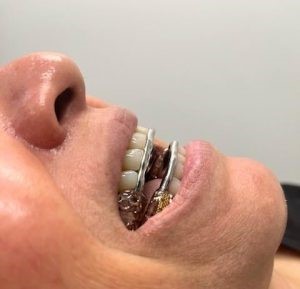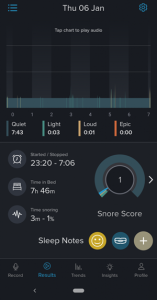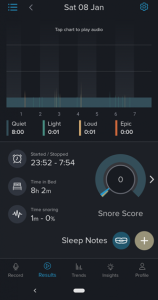
Dr. Whitman recently treated a patient with mild sleep apnea. The patient’s primary complaints were snoring and feeling tired even after a full night’s sleep.
Upon examination, Dr. Whitman found that when the patient laid on her back, she had a restricted airway due to her lower jaw retruding far back and her tongue blocking much of the passage.
The patient had a small mouth with slight crowding of her teeth, which did not allow her tongue to sit comfortably when she laid on her back. Dr. Whitman also found that the tongue was scalloped, a sign of obstructive sleep apnea.
What Is Obstructive Sleep Apnea (OSA)?
Obstructive sleep apnea causes pauses in breathing during sleep, which results in a lack of oxygen throughout the body. These pauses in breathing happen a handful of times up to hundreds of times in a single night, depending on the severity of the condition.
The severity of sleep apnea is measured by AHI (apnea-hypopnea index). AHI can range from five to hundreds of episodes per night. According to the American Academy of Sleep Medicine, over 20 million Americans have sleep apnea.
A few of the signs and symptoms of sleep apnea include:
- Waking up with a dry mouth or throat
- Snoring
- Lack of restful sleep and energy (even with a full night’s sleep)
- Depression
- Forgetfulness
- Morning headaches
- Interrupted sleep accompanied by waking with a gasping sensation
- Sleep-related teeth grinding
Those with undiagnosed or untreated moderate to severe sleep apnea can even have cardiovascular episodes and sudden death.
A dental visit is often the first place patients can inquire about sleep apnea. Your dentist can assist in diagnosis. Often, a sleep test and working with an ear, nose, and throat (ENT) doctor is needed. A continuous positive airway pressure (CPAP) machine is usually indicated for severe cases. However, different types of oral appliances may be the solution for mild to moderate cases.
Diagnosing Sleep Apnea With an At-Home Test
The patient was not interested in orthodontics and also hesitant to go to a sleep center for a study, which would have confirmed her sleep apnea diagnosis.
Dr. Whitman was able to help set the patient up with an at-home sleep study. The patient had the device sent directly to her house and used it during her sleep. She then sent it back to the company, which promptly processed it and sent back results. Working with an ENT and the sleep study company, Dr. Whitman found that the patient had an AHI of up to 13, which indicated mild obstructive sleep apnea.
The patient did not want to get a CPAP machine and, according to the ENT, did not necessarily need one with her mild symptoms. It was recommended that she be fitted for an oral appliance.
Using Oral Appliance Therapy to Treat Sleep Apnea
In the first appointment, Dr. Whitman took impressions and measurements to fabricate a mandibular advancement device for the patient. This device allows for less restricted airflow and reduced snoring while sleeping.
During two subsequent appointments, adjustments were made in small millimeter increments to ensure the appliance and position of the device were comfortable enough but also effective enough for the patient. The patient also downloaded a sleep app to track her snoring and found that, with each adjustment, the occurrence of snoring was reduced significantly.
Another at-home sleep study was ordered after the patient used the device for two weeks. This time, the AHI recorded only one to three episodes a night. Most nights, there were no episodes at all.
Dr. Whitman continually monitors and adjusts the sleep apnea device as needed for the patient, who is experiencing many more restful nights of sleep and, as a result, an improved quality of life.
These are photos from the patient’s sleep app after the second adjustment showing her sleep cycle, restfulness, and significant reduction in snoring.

